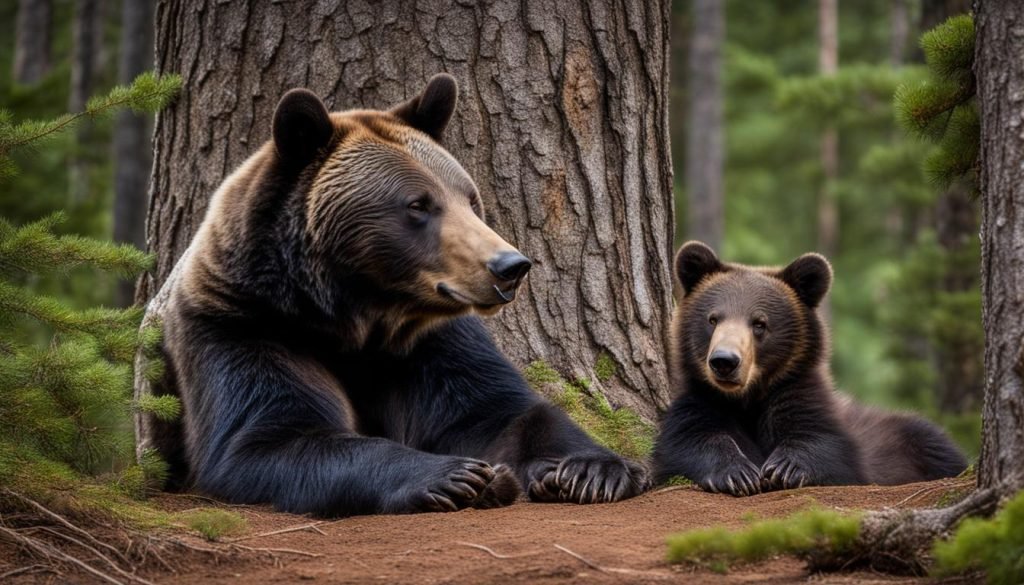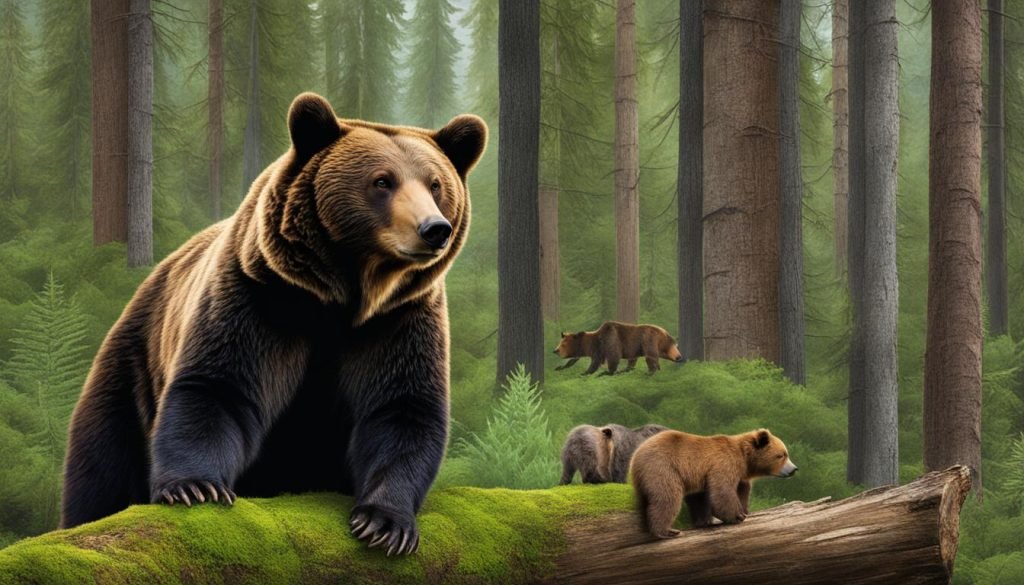How Long Do Bears Live?
Bears are among the most fascinating and powerful creatures in the natural world. From the grizzly bears of Yellowstone to the polar bears of the Arctic, these majestic animals capture the imaginations of nature enthusiasts across the globe. One of the most common questions asked about bears is how long they live, and this is precisely what we will explore in this article.
Understanding the lifespan of bears is key to appreciating their unique adaptations and the challenges they face in their natural habitats. From the impact of climate change on polar bears to the struggles of brown bears as they compete for resources, bear longevity is a fascinating topic that is important to study and understand.
Key Takeaways:
- Bears are among the most fascinating and powerful creatures in the natural world.
- One of the most common questions asked about bears is how long they live.
- Understanding the lifespan of bears is key to appreciating their unique adaptations and the challenges they face in their natural habitats.
- Climate change is affecting the lifespan of polar bears.
- Competition for resources is a key factor affecting the lifespan of brown bears.
Bear Lifespan: Understanding the Basics

Bears are fascinating creatures that have captured our attention for centuries. Understanding the basics of bear lifespan is key to unlocking the secrets of these majestic animals.
On average, bears can live from 20 to 30 years in the wild, depending on their species and habitat. However, some bears have been known to live much longer – the oldest known bear was a female brown bear who lived in Sweden for 43 years.
Many factors can impact the lifespan of bears. These include genetics, habitat, diet, and environmental factors such as climate change and human interactions.
Despite these challenges, bears have amazing adaptations that allow them to survive and thrive in their natural habitats. For example, bears have a slow metabolism and can enter a state of hibernation to conserve energy during harsh winters.
Understanding the basics of bear lifespan can help us appreciate and protect these remarkable animals. Let’s continue our exploration by taking a closer look at the specific lifespans of different bear species.
How Long Do Bears Live: The Longevity of Brown Bears

Brown bears, also known as grizzly bears, are a subspecies of the North American brown bear. They are found in several regions around the world, including North America, Europe, and Asia. Despite their widespread distribution, their lifespan in the wild varies greatly depending on various factors.
The average brown bear lifespan:
The average lifespan of brown bears in the wild is between 20 to 25 years. However, some brown bears have been known to live up to 30 years in the wild. It is essential to mention that the lifespan of brown bears in captivity is often shorter than those in the wild. Several factors influence the lifespan of brown bears.
Factors that Influence Brown Bear Lifespan:
| Factors | Description |
|---|---|
| Food Availability | The food availability affects the lifespan of brown bears as it ensures that the bear has enough to eat, which can lead to better health and a longer life expectancy. |
| Competition for Resources | Brown bear’s lifespan can be influenced by competition for resources like food and habitat due to the effects of competition on the bear’s health and ability to survive. |
| Genetics | Genes play a crucial role in determining the lifespan of bears. Studies show that genetic factors are essential determinants of lifespan among brown bears. |
| Environmental Factors | Several environmental factors, like weather conditions, availability of resources, and habitat quality, can influence brown bear lifespan. |
An additional factor that may influence the lifespan of brown bears which is beyond human control is natural calamities such as wildfires or droughts.
In summary, brown bears have an average lifespan of between 20 to 25 years in the wild, with several factors influencing their longevity, including food availability, competition for resources, genetics, environmental factors, and natural disasters. Understanding the factors that determine the lifespan of brown bears helps to create awareness about the unique needs of these animals and the need to protect them to ensure their continued survival.
Black Bear Lifespan: A Closer Look

Black bears are known to inhabit the forests of North America, showcasing their elusive nature to those who seek to catch a glimpse of them. In terms of their lifespan, black bears are known to live for a relatively decent amount of time in the wild, reaching up to 25 years of age on average.
However, the lifespan of a black bear can change depending on various factors. For instance, their lifespan can be influenced by the habitat they live in, particularly if they have access to a stable food supply and a healthy environment to live in. Another factor that can affect their lifespan is their size, as larger bears are more susceptible to disease and are more likely to endure injuries during fights with other bears.
| Factors Affecting Black Bear Lifespan | Impact on Lifespan |
|---|---|
| Gender | Male bears typically have a shorter lifespan due to their more engaging lifestyle compared to female bears. Females have a longer lifespan due to their lesser engagements and higher protection over their cubs. |
| Food Availability | If black bears have a stable food supply, they can live longer lives due to their lesser need to venture out and search for food. |
| Human Hunting | Black bears that are regularly hunted by humans have a shorter lifespan due to the increased risks and stress due to hunting pressure. |
Black bears provide insight into the diverse outcomes possible in bear populations. Factors like the availability of food and prey, quality of their habitat, human intervention, and genetic makeup play a significant role in determining black bear’s lifespan in their natural habitats. Understanding these dynamics is imperative to create policies that protect the species from long-term lifespan threats.
Polar Bear Lifespan: Surviving in the Arctic
In the freezing, icy landscapes of the Arctic, polar bears are perfectly adapted for survival. With their thick, waterproof fur and large, webbed paws, these incredible creatures are built to withstand the extreme conditions of their habitat.
But how long do polar bears live? The average polar bear lifespan is around 25-30 years in the wild, although some have been known to live longer.
However, despite their impressive adaptations, polar bears face a range of challenges that can impact their lifespan. These include:
- Climate change: The Arctic is warming at twice the rate of the rest of the world, leading to habitat loss and changes to food sources for polar bears.
- Hunting: While hunting polar bears is illegal in many countries, climate change has led to an increase in hunting as the bears are forced to search for food on land, bringing them into closer contact with humans.
- Pollution: Contamination of the Arctic environment with chemicals and toxins can impact polar bear health and lifespan.
Despite these challenges, polar bears continue to adapt and thrive in their frozen home. By studying the average polar bear lifespan and the factors that impact their longevity, we can gain a deeper understanding of these remarkable creatures and the importance of preserving their unique habitat.
Grizzly Bear Lifespan: Strength and Resilience

Grizzly bears are one of the largest bear species, and their strength and resilience are nothing short of impressive. These powerful creatures are well-adapted to life in the wild, with sharp senses and formidable hunting skills. But how long do grizzly bears live in their natural habitats?
The average lifespan of a grizzly bear in the wild is around 20-25 years, although some have been known to live up to 30 years. Like other bears, the lifespan of grizzly bears can be influenced by various factors, including genetics, diet, and environment.
One of the key factors that can impact the lifespan of grizzly bears is their diet. Grizzly bears are opportunistic feeders, eating a variety of food including berries, nuts, fish, and small mammals. However, in some areas, grizzly bears have been known to scavenge from human sources, such as garbage dumps, which can hurt their health and lifespan.
Another factor that can influence the lifespan of grizzly bears is their environment. These bears are well-adapted to living in rugged, mountainous areas, but habitat loss and fragmentation due to human activities can pose significant threats to their survival. Climate change is also a concern, as rising temperatures and changing weather patterns can impact the availability of food and other resources that grizzly bears rely on.
Despite these challenges, grizzly bears continue to thrive in many parts of their range, thanks to their strength, resilience, and adaptability. By understanding the factors that impact their lifespan, we can continue to work towards protecting these remarkable creatures and ensuring that they have a future in the wild.







